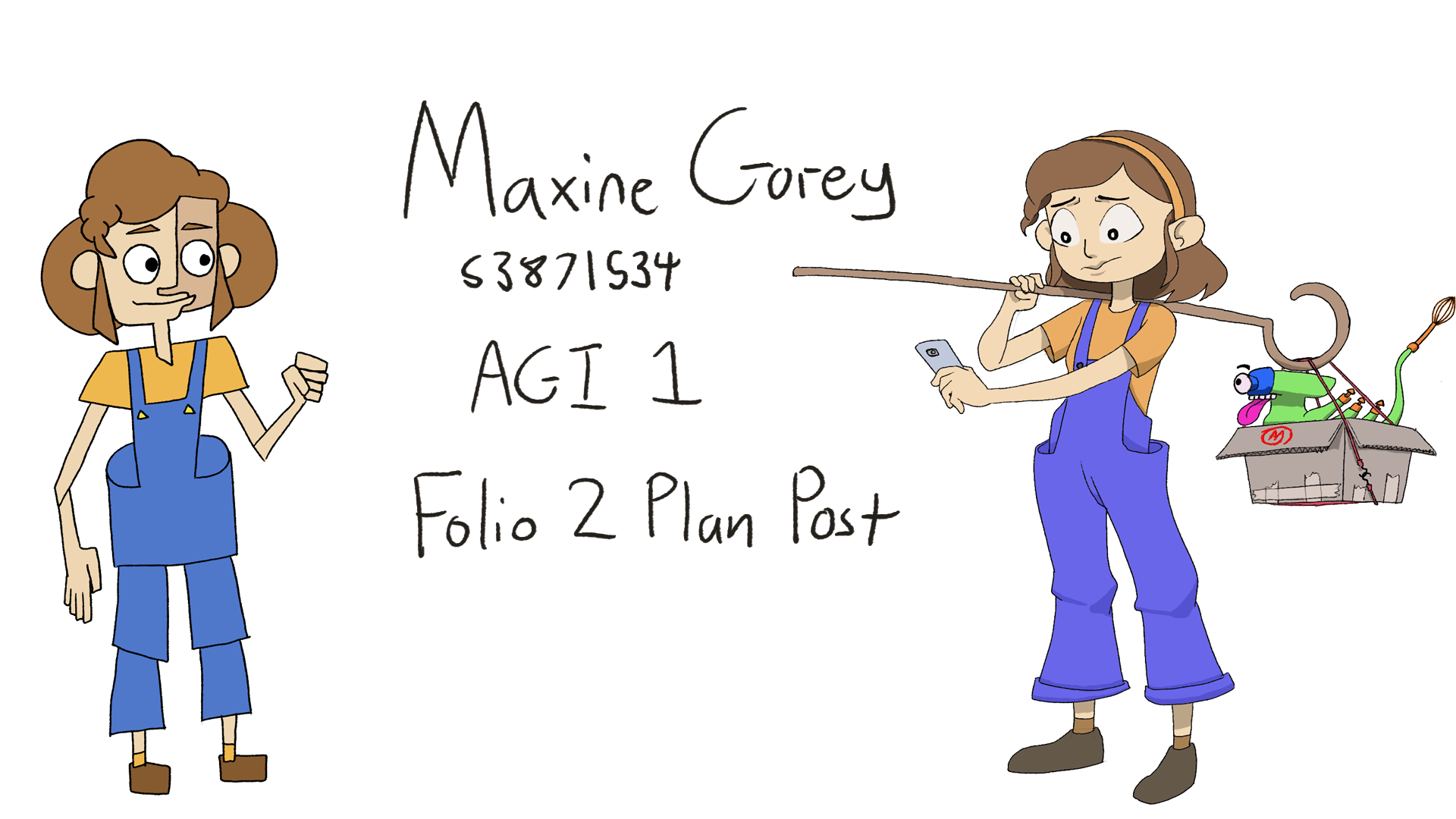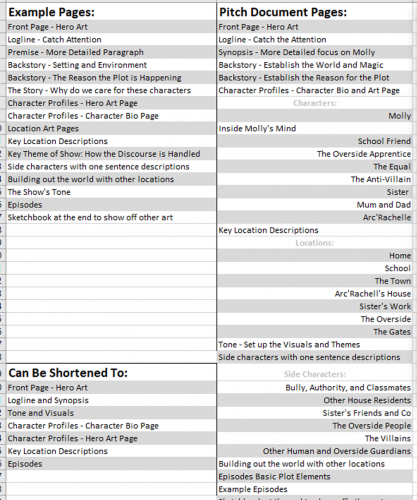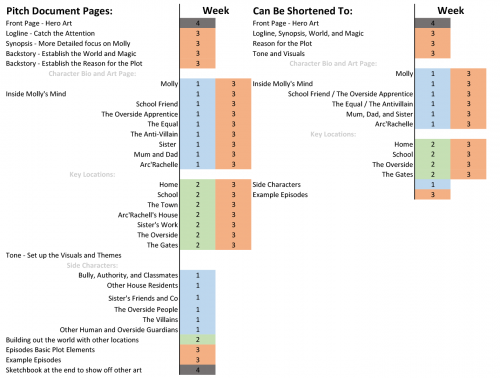
Through my AGI Studio One project I am looking into the theory of developing an idea for a children’s animated television program and using that in practice to create a pitch document for a series.
The series idea I’m working on is called Molly of the Overside. The target audience for the show would be around the ages of 9 to 12.
I want to find and learn what is important when designing a show idea like mine. Specifically, what to be mindful of when designing for that age group (whether I need to change the age group) and what do I need to talk about in regards to the show being animated (the style of the show, and how it makes use of animation as a medium).
There are also aspects of scriptwriting that I need to work on. There are things that I have learned through my related works posts so far that I need to integrate into my project.
Example: Shows that are engaging will have a story that has been instigated by the main character or someone close to them. This gives the character a connection with the plot, and helps establish a goal for the season.
For ‘GRAP2627 Research Methods for Design and Digital Media’ I have been reading about animated television development and the discussions around it. One thing I have found is that since the advent of online streaming services such as Netflix there has been a push within Australia for children’s programming that has a specific Australian culture to help kids establish a sense of place. These online streaming services are also an avenue for funding, and will be looking to increase their catalogue of children’s content, as this programming can be a deciding factor when a family is looking to subscribe to a service. There is an issue in that these streaming services will be looking for content to licence for the international market, and they can push back against content that is too Australian. The children’s program ‘Bluey’ is an interesting case-study, as it has held onto it’s Australian identity, even managing to avoid a second recording with an American cast when it went to Disney+. ‘Bluey’ did have a lot of parties involved, with support from people within the ABC, Screen Australia, and the BBC to help with the deal.
With this in mind I would like to develop Molly of the Overside with an Australian aesthetic in its environments, clothing, architecture, and animals, whilst still having the main story be about magic and monsters.
By the end of AGI Studio One I want to have a show concept that feels solid. This would be achieved by developing a logline that catches the attention of the reader, and a synopsis that is succinct by being able to establish all the details for how the world and the magic works. The main character would be engaged with the plot of the show, and be an underdog that the audience wants to see succeed. All the supporting characters would have specific reasons for iterating with the main character, and have descriptions for how the main character feels about them. This would also be true for the environments, with descriptions on how the main character feels in them. Everything will tie back to the main character to really sell them as the reason for the show.
Talking about the tone of the show will also be important. Some other research I have come across is talking about the current generation that is growing up, Generation Alpha, being a very social connected and aware generation. The current rise of representation in children’s media with various cultures, identities, genders, and sexualities appearing within stories has been great, but the theory is Generation Alpha will expect more. Within the document I intend to discuss the tone of the show by laying out how characters resolve disputes and how negative emotions are handled. I want to imbue the show with my own experiences relating to gender, sexuality, and ADHD. ADHD will be an easier one to go into detail with, and I feel should help give the main character a distinct appeal. I am wary about trying to talk about queer characters in a cartoon, and have concerns about how being open with it in a pitch document may limit the options. This is something I will have to investigate further, as the only recent examples I can think of (Steven Universe; She-Ra and the Princesses of Power) both involved the creators working in gay characters during production, and either trying to fly it under the radar until it was too difficult for a higher-up to remove, or through sheer will and determination to fight for the inclusion.
I’m hoping that AGI Studio One will push me to refine and rework the art style and writing for the show idea, as before now, in my own time, the development of an idea would have been very linear and without reflection.
The project will involve the use of Adobe Photoshop to create the artwork and Adobe InDesign to create the final document. Other word processing software will be used when writing and developing the story and characters.
Going forward there are four studio sessions left before week thirteen. If I went with my plan to create a highly detailed document it would contain 32 pages. The general layout would be a bit of character art to one side to accompany the text on the page.
The most important pages are the front cover, logline, synopsis, tone, visual aesthetic, character profiles for seven major characters, descriptions for seven major locations, and a list of example episodes. Some of these can be combined into one page and could have more simple character art or other in-universe objects to decorate the page.
Going with the larger plan would need at least eight pages locked down every week. The pages related to characters, backgrounds, and the front cover are the most intensive art-wise. The synopsis, logline, backstory, and example episode pages would require more writing work to make sure they are succinct and of good quality.
At the moment the major roadblock is confirming the artstyle for the Overside characters and locations, thankfully I have been able to make some progress.
One way to plan out the project is to group like-elements together over the four weeks. First week is for locking down the art for all characters. Second week is for locking down all environmental art. Third week is for locking down all the writing. The fourth week would be for designing the layout of the document and creating the hero-art for the front cover.
In practice this would end up with 15 art assets in the first week, eight art assets in the second week, 22 pages requiring writing in the third week (nine pages of character bio, seven pages of location descriptions, the episode examples, and all the detail at the beginning of the document), and then week four would have the hero-art and document designing.
Provided I can establish a quick art style for drawing backgrounds the second week could provide some leeway. I have collected some inspiration art as reference that uses large shapes, and quick coloured lines for detail, without a specific outline for objects. The third week is looking to be the most intensive here, as I can find it difficult at times to decide when to stop revising my writing and move on.
This is a lot of work to complete over four weeks, especially as I can’t dedicate it all to this project, so downgrading the scope will be necessary. I will use my shortened project scope as a guide for which assets to work on first, and should I fall behind the schedule I can redefine the contents of the document and scale it down towards the smaller option.
About This Work
By Maxine Gorey
Email Maxine Gorey
Published On: 14/09/2020


